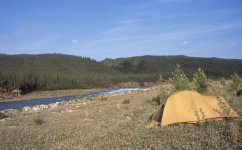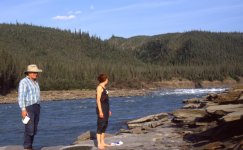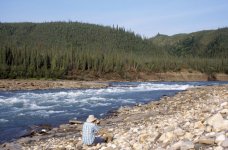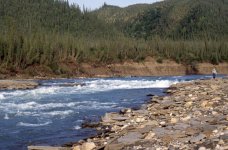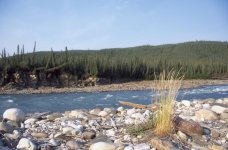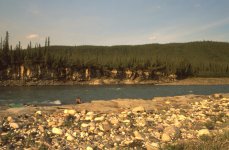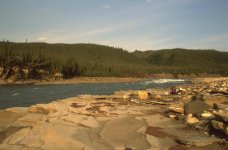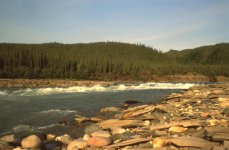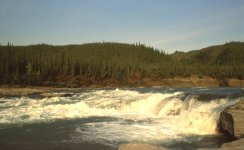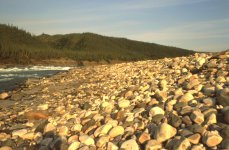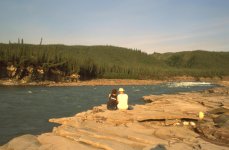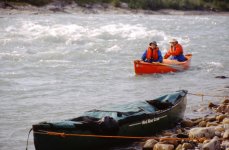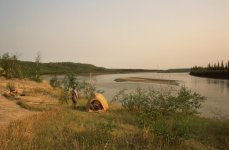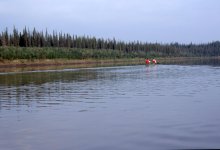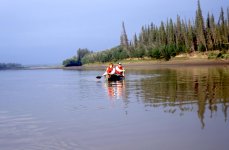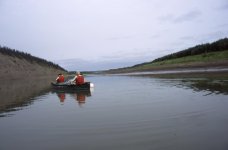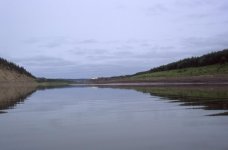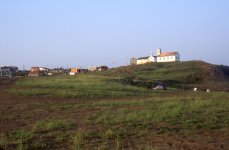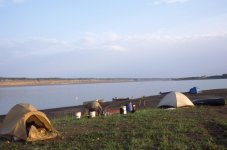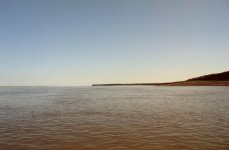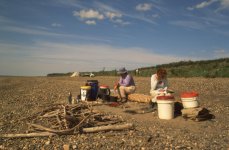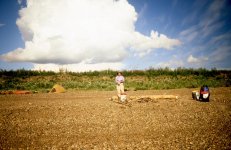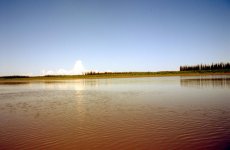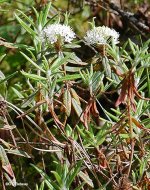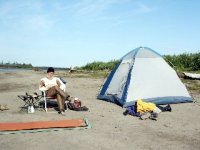- Joined
- Aug 21, 2018
- Messages
- 1,812
- Reaction score
- 4,582
In the fall of 2003, Kathleen and I developed an itinerary for our canoe trip for the following summer down the Arctic Red River in the Northwest Territories.
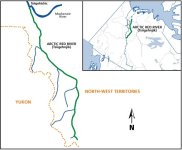
The Arctic Red River became part of the Canadian Heritage Rivers System in 1993, and appealed to us for several reasons. It was a fairly long trip, at nearly three weeks to paddle 509 km (316 miles). It was a far northern trip, beginning at about 64 degrees 40 minutes north, and ending at about 68 degrees 35 minutes north. We would enjoy nearly constant daylight, which is a major draw for Kathleen and me. We would begin by driving to the home of our friends Marilyn and Alan in Inuvik, from where we would fly almost to the headwaters of the Arctic Red River. We would end our trip back in Inuvik by paddling the last 115 km (71 miles) down the Mackenzie River after its confluence with the Arctic Red. This would be a great trip. We looked forward to it.
For more information about the the Arctic Red River, this link takes you to the Canadian Heritage Rivers site:
http://chrs.ca/the-rivers/arctic-red/designation/
You will see that the Gwich’in people called the Arctic Red River, “Tsiigehnjik,” which means “iron river” and refers to iron or mineral deposits upstream from their traditional community.
That fall of 2003, Kathleen and I gave a slide show to our Beaver Canoe Club on one of our northern canoe trips. I don’t remember which one. Doesn’t really make any difference. Afterwards, as I was packing up, Donna came over to tell me how much she enjoyed the presentation. That’s always nice to hear. Eventually she said, “Don and I joined the club so that we could learn to canoe, and eventually go on a northern canoe trip. So far we haven’t gone on any northern canoe trips.”
I didn’t know Don & Donna very well. They had only been members for a couple of years. They were nice people, though. I sympathized with Donna. “Kathleen and I are going on the Arctic Red River next summer. Would you like to come along?”
“Yeah, we would.”
This surprised me a little. They weren’t really very good canoeists yet. And besides, I was just being nice. “It’s a long trip, Donna. Very isolated. I don’t have much information about it. I don’t know how difficult the rapids might be.”
“I’ll go get Don.” Don came over, and said, “Yeah. We want to come with you.”
So, Don & Donna joined our little group.
Next summer, on the way up to Inuvik, which was about a seven-day drive, I began to have concerns about our wilderness canoeing companions. Don always seemed to be in such a hurry, driving much faster than Kathleen and I preferred. He rarely stopped to enjoy the scenery, particularly on the Dempster Highway. We struggled to keep up, and always trailed in a cloud of dust.
When we finally reached Inuvik, the sky was filled with smoke from forest fires. The owner of the float plane company said that we couldn’t fly into the Arctic Red River on the day as planned because of too much smoke. After the first day, Don seemed very impatient. On the second day, we met Don & Donna for lunch. Don reported that he “had been looking at topographic maps at the library. We can’t wait around much longer. I think we should change our plans and fly east to paddle the Hornaday River. There isn’t as much smoke east of Inuvik, and we could fly in tomorrow.”
“I don’t think so, Don” We don’t have any maps for the Hornaday River. And besides, I’ve read that it’s not a suitable river for canoeists.”
“That’s what the float plane guy said too. But I think we should do it. We can’t wait around forever.”
“I don’t want to paddle the Hornaday, Don. It doesn’t end up anywhere near Inuvik. There would be extra cost. We don’t have maps, and it’s not suitable for canoeists. I’m going to wait until the smoke clears enough for us to fly into the Arctic Red River.”
Don seemed to accept this, but only grudgingly.
(Note: I would now like to quote from Canoeing Canada’s Northwest Territories: A Paddler’s Guide. This is where I had obtained my knowledge about the Hornaday River.
“At latitude 68 degrees 55 minutes, longitude 122 degrees 42 minutes, the scenery and nature of the river change dramatically. The peaceful river quickly becomes a dangerous, raging torrent, culminating in a 45 km (28 mile) canyon that drops 300 m (984 feet) along its length. There are 150 to 200 rapids in the canyon, many of which are Class 5 and 6, including the 20 m (66 foot) high La Ronciere Falls. The canyon is very narrow and in many place it is impossible to climb out or to set foot on the side of the river. Frequent stone avalanches make travel even more hazardous.”)
I think you see my point. I was going to wait until the smoke cleared.

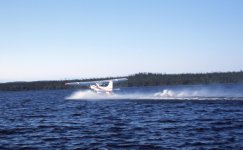
And indeed, the next morning, Don & Donna took off from Shell Lake on their way to the Arctic Red River. By the time the plane returned, the smoke had also returned. Kathleen and I hung around all day, but finally flew in after supper. Most paddlers on the Arctic Red River fly into Otter Lakes, which is about 1 km (0.5 miles) from the river. When we landed, Don hurried over to help us lug our gear to the river. That was very generous on his part, but he was in such a hurry. He started loading and dragging our gear the second we touched down. “Wait a minute, Don. Kathleen and I have a system for what stuff goes in what pack, and what we carry first. It works for us. We never lose or misplace anything. I’d like to just slow down here a little bit, it you don’t mind.”
Don seemed miffed, but we eventually got all of our stuff to the river, and set up camp for the night.
I think you can see where I’m going with this. I’m curious how other people might vet wilderness canoeing companions. I’m also wondering it anyone on this site has ever paddled the Arctic Red River. I don’t know anyone who has. I’d be very interested in your impressions.
It’s pretty much time for our supper now. I will continue this tomorrow.

The Arctic Red River became part of the Canadian Heritage Rivers System in 1993, and appealed to us for several reasons. It was a fairly long trip, at nearly three weeks to paddle 509 km (316 miles). It was a far northern trip, beginning at about 64 degrees 40 minutes north, and ending at about 68 degrees 35 minutes north. We would enjoy nearly constant daylight, which is a major draw for Kathleen and me. We would begin by driving to the home of our friends Marilyn and Alan in Inuvik, from where we would fly almost to the headwaters of the Arctic Red River. We would end our trip back in Inuvik by paddling the last 115 km (71 miles) down the Mackenzie River after its confluence with the Arctic Red. This would be a great trip. We looked forward to it.
For more information about the the Arctic Red River, this link takes you to the Canadian Heritage Rivers site:
http://chrs.ca/the-rivers/arctic-red/designation/
You will see that the Gwich’in people called the Arctic Red River, “Tsiigehnjik,” which means “iron river” and refers to iron or mineral deposits upstream from their traditional community.
That fall of 2003, Kathleen and I gave a slide show to our Beaver Canoe Club on one of our northern canoe trips. I don’t remember which one. Doesn’t really make any difference. Afterwards, as I was packing up, Donna came over to tell me how much she enjoyed the presentation. That’s always nice to hear. Eventually she said, “Don and I joined the club so that we could learn to canoe, and eventually go on a northern canoe trip. So far we haven’t gone on any northern canoe trips.”
I didn’t know Don & Donna very well. They had only been members for a couple of years. They were nice people, though. I sympathized with Donna. “Kathleen and I are going on the Arctic Red River next summer. Would you like to come along?”
“Yeah, we would.”
This surprised me a little. They weren’t really very good canoeists yet. And besides, I was just being nice. “It’s a long trip, Donna. Very isolated. I don’t have much information about it. I don’t know how difficult the rapids might be.”
“I’ll go get Don.” Don came over, and said, “Yeah. We want to come with you.”
So, Don & Donna joined our little group.
Next summer, on the way up to Inuvik, which was about a seven-day drive, I began to have concerns about our wilderness canoeing companions. Don always seemed to be in such a hurry, driving much faster than Kathleen and I preferred. He rarely stopped to enjoy the scenery, particularly on the Dempster Highway. We struggled to keep up, and always trailed in a cloud of dust.
When we finally reached Inuvik, the sky was filled with smoke from forest fires. The owner of the float plane company said that we couldn’t fly into the Arctic Red River on the day as planned because of too much smoke. After the first day, Don seemed very impatient. On the second day, we met Don & Donna for lunch. Don reported that he “had been looking at topographic maps at the library. We can’t wait around much longer. I think we should change our plans and fly east to paddle the Hornaday River. There isn’t as much smoke east of Inuvik, and we could fly in tomorrow.”
“I don’t think so, Don” We don’t have any maps for the Hornaday River. And besides, I’ve read that it’s not a suitable river for canoeists.”
“That’s what the float plane guy said too. But I think we should do it. We can’t wait around forever.”
“I don’t want to paddle the Hornaday, Don. It doesn’t end up anywhere near Inuvik. There would be extra cost. We don’t have maps, and it’s not suitable for canoeists. I’m going to wait until the smoke clears enough for us to fly into the Arctic Red River.”
Don seemed to accept this, but only grudgingly.
(Note: I would now like to quote from Canoeing Canada’s Northwest Territories: A Paddler’s Guide. This is where I had obtained my knowledge about the Hornaday River.
“At latitude 68 degrees 55 minutes, longitude 122 degrees 42 minutes, the scenery and nature of the river change dramatically. The peaceful river quickly becomes a dangerous, raging torrent, culminating in a 45 km (28 mile) canyon that drops 300 m (984 feet) along its length. There are 150 to 200 rapids in the canyon, many of which are Class 5 and 6, including the 20 m (66 foot) high La Ronciere Falls. The canyon is very narrow and in many place it is impossible to climb out or to set foot on the side of the river. Frequent stone avalanches make travel even more hazardous.”)
I think you see my point. I was going to wait until the smoke cleared.


And indeed, the next morning, Don & Donna took off from Shell Lake on their way to the Arctic Red River. By the time the plane returned, the smoke had also returned. Kathleen and I hung around all day, but finally flew in after supper. Most paddlers on the Arctic Red River fly into Otter Lakes, which is about 1 km (0.5 miles) from the river. When we landed, Don hurried over to help us lug our gear to the river. That was very generous on his part, but he was in such a hurry. He started loading and dragging our gear the second we touched down. “Wait a minute, Don. Kathleen and I have a system for what stuff goes in what pack, and what we carry first. It works for us. We never lose or misplace anything. I’d like to just slow down here a little bit, it you don’t mind.”
Don seemed miffed, but we eventually got all of our stuff to the river, and set up camp for the night.
I think you can see where I’m going with this. I’m curious how other people might vet wilderness canoeing companions. I’m also wondering it anyone on this site has ever paddled the Arctic Red River. I don’t know anyone who has. I’d be very interested in your impressions.
It’s pretty much time for our supper now. I will continue this tomorrow.
Last edited:

